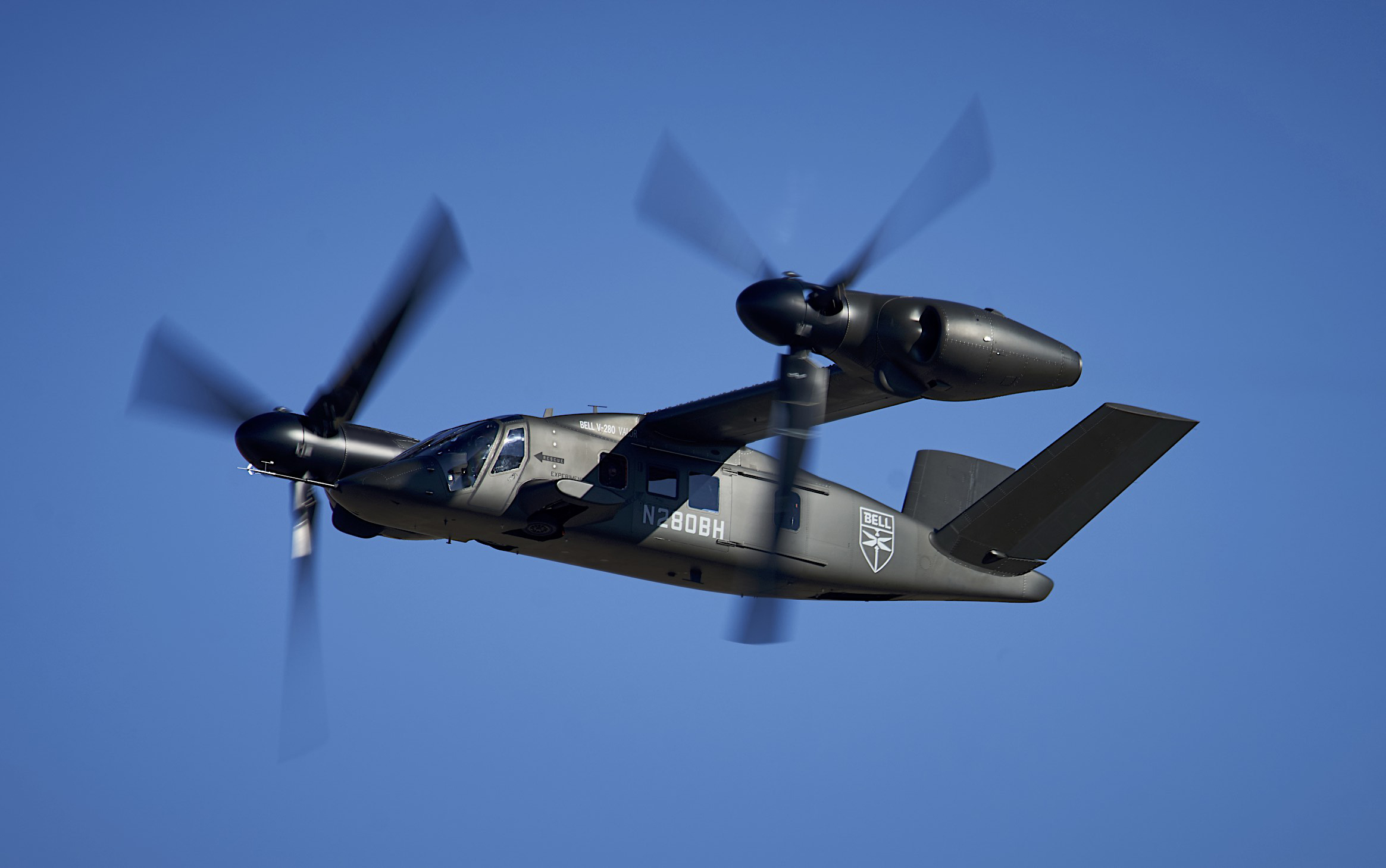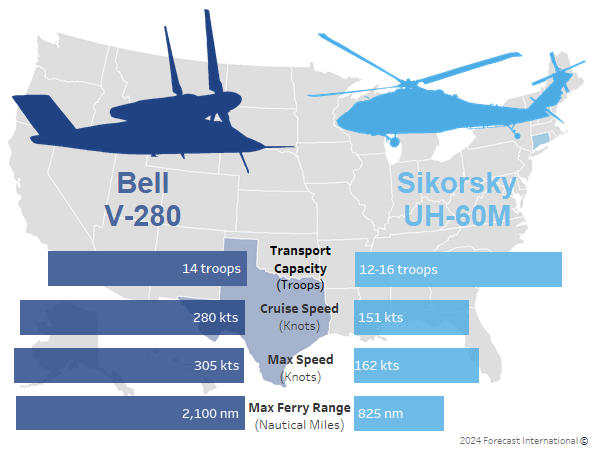
Following the largest domestic defense exhibit focused on the U.S. Army, Future Long Range Assault Attack (FLRAA), the service’s upcoming aircraft acquisition program, is gaining momentum. Part of the Army’s Future Vertical Lift (FVL) initiative, FLRAA will procure a form of Bell Textron’s V-280 Valor tiltrotor to supplement and potentially replace part of the UH-60 Black Hawk fleet.
With the Army’s decision in August to approve Milestone B, FLRAA entered the Engineering and Manufacturing Development (EMD) phase, allowing Bell to build six prototypes and prepare for Low Rate Initial Production (LRIP).
FLRAA will usher in a new era of speed and range for Army aviation
Like its Bell-Boeing V-22 Osprey predecessor, FLRAA’s tiltrotor design radically alters expectations of conventional rotorcraft. FLRAA’s two Rolls-Royce AE 1107F engines allow a cruise speed of 280 knots. The V-280 demonstrator has recorded a max speed of 305 knots.
With the V-280’s 2,100 nm ferry range, the Valor doubles the speed and range of the Army’s latest Black Hawk, the UH-60M. FLRAA’s performance will allow Army planners to introduce previously impractical operations. The Army is currently experimenting with transporting a Brigade Combat Team over 500 miles nocturnally, a feat primarily driven by FLRAA’s capabilities.
FLRAA’s speed and range, which improves sustainability, survival, logistics, and maintenance, will introduce tiltrotor capabilities to Army decision-makers, already appreciated by the other service branches in the V-22 Osprey.
Tiltrotor capabilities represent a truly categorical revolution in military flight operations. Army aviation has historically and primarily operated as a helicopter-centric force. Pilots and crews skilled at nap-of-the-earth (NOE) flying and terrain-masking at slow airspeeds will need to learn how to employ an aircraft that cruises at speeds twice that of the Black Hawk.
Military helicopter pilots fly most of their training and operational sorties at plus or minus 100 knots, 500 feet, or below while using visual navigation under visual flight rules (VFR). FLRAA will open up more regular and routine flying at higher altitudes and airspeeds under instrument flight rules (IFR).
Tiltrotors will alter the dynamics of traditional troop insertion and extraction, airborne communications, and defense against ground-based threats. Future Army pilots will require early pipeline training to adapt accordingly.
Acquiring FLRAA will involve a shift in Army aviation mindset and culture, one the Marine Corps has accomplished with the V-22 Osprey over decades of flying. Army leaders are working with experienced Marine aviators to form training, tactics, and best practices to leverage tiltrotor technology. Simply, FLRAA will change the thought calculus for conducting air assault warfare.
FLRAA won’t be the V-280
When the U.S. Army receives its first FLRAA, it will be a different rotorcraft than Bell’s V-280 demonstrator. Army officials say it will be renamed and designated upon service entry.
As the customer and builder tweak and finalize the production aircraft design, adjustments will occur. Some observers have pointed out changes to the body and wing fairing lines in recent FLRAA models.
Before the Milestone B decision, Special Operations Command (SOCOM) began working with the Army to ensure FLRAA would meet its operational needs. SOCOM leaders plan to add terrain-following radar and a refueling probe to the aircraft for initial fielding in the mid-2030s. .
Additional design modifications could continue over the next year as the program lifecycle matures, with early production slated during 2028.
FLRAA design differs from the V-22 tiltrotor
Perhaps the most pressing issue facing FLRAA is implementing lessons learned from 17 years of V-22 Osprey operations. Given the V-22 tiltrotor’s recent perception problem and mechanical troubles, getting FLRAA right remains paramount for the Pentagon.
Although the V-280 is cut from the same cloth as the Bell/Boeing Osprey, engineers have implemented certain differences from the start. While the V-22’s nacelles, which house both the engine and gearbox, fully rotate, only the V-280’s props and gearbox move while the engines remain fixed during transitioning flight.
The V-280 also features a different clutch than the V-22, one that operates more like that of a conventional helicopter. The Osprey’s transmission has been linked to fatal hard-clutch engagements and requires an 800-hour parts replacement. Aside from a smaller overall footprint, the V-280 uses a V-tail configuration rather than the V-22’s twin vertical fin tail.
Bell aims to differentiate FLRAA’s global marketability from the V-22’s. Japan remains the sole foreign military that flies the Osprey. Depending on FLRAA’s initial track record, the rotorcraft could find several international buyers keenly observing the second American-built tiltrotor’s evolution. Australia has emerged as an early possible sales target for Bell.
Much rests on FLRAA’s anticipated success. Army leaders continue to vocalize the importance of FLRAA’s modularity, affordability, and performance. While FLRAA stands to transform air assault and Army aviation for the next generation of warfare, that realization depends on a steady drumbeat of effective pre-production planning, program milestones, and on-target deliverability.
A former naval officer and helicopter pilot, Jon covers a range of Forecast International reports and products, drawing on his 10-year background in military aviation, operations, and education. His previous military assignments include multiple overseas deployments supporting operations in the Arabian Gulf, NATO exercises, and humanitarian missions. Jon’s work is also influenced by his time as a former Presidential Management Fellow and international trade specialist at the Department of Commerce.
Before joining Forecast International, Jon also served as an NROTC instructor and Adjunct Assistant Professor at the University of Texas, where he taught undergraduate courses on naval history, navigation, defense organization, and naval operations and warfare. A lifelong reader and learner, his academic and professional interests include aviation, political and military history, national defense and security, and foreign area studies.




